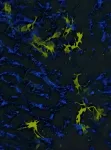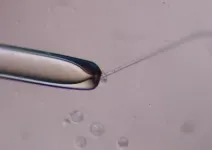Cancer: Immunotherapies without side effects?
By identifying the mechanism of toxicity induced by immunotherapies, scientists from UNIGE and from the Harvard Medical School are paving the way for cancer treatments with fewer side effects
2021-07-02
(Press-News.org) In recent years, immunotherapy has revolutionised the field of cancer treatment. However, inflammatory reactions in healthy tissues frequently trigger side effects that can be serious and lead to the permanent discontinuation of treatment. This toxicity is still poorly understood and is a major obstacle to the use of immunotherapy. Scientists from the University of Geneva (UNIGE), Switzerland, and Harvard Medical School, United States, have succeeded in establishing the differences between deleterious immune reactions and those targeting tumour cells that are sought after. It appears that while the immune mechanisms are similar, the cell populations involved are different. This work, published in the journal Science Immunology, makes it possible to envisage better targeted, more effective, and less dangerous treatments for cancer patients.
Based on massive stimulation of the patient's immune system, immunotherapies have saved many lives. Unfortunately, they are not without consequences. "When the immune system is activated so intensively, the resulting inflammatory reaction can have harmful effects and sometimes cause significant damage to healthy tissue", says Mikaël Pittet, holder of the ISREC Foundation Chair in Onco-Immunology at UNIGE Faculty of Medicine Department of Pathology and Immunology and Centre for Translational Research in Onco-Haematology, and a member of the Swiss Cancer Centre Leman. "Therefore, we wanted to know if there are differences between a desired immune response, which aims to eliminate cancer, and an unwanted response, which can affect healthy tissue. The identification of distinctive elements between these two immune reactions would indeed allow the development of new, more effective and less toxic therapeutic approaches."
Using liver biopsy samples from patients treated at the CHUV and the HUG who had suffered such toxic reactions, the scientists studied the cellular and molecular mechanisms at work to reveal similarities and dissimilarities.
A similar response, but with different cells
In an immunotherapy-related toxic response, two types of immune cells -- macrophage and neutrophil populations -- appear to be responsible for attacking healthy tissue, but are not involved in killing cancer cells. In contrast, another cell type -- a population of dendritic cells -- is not involved in attacking healthy tissue but is essential for eliminating cancer cells. "Immunotherapies can trigger the production of specialised proteins that alert the immune system and trigger an inflammatory response, explains Mikaël Pittet. In a tumour, these proteins are welcome because they allow the immune system to destroy cancerous cells. In healthy tissue, however, the presence of these same proteins can lead to the destruction of healthy cells. The fact that these inflammatory proteins are produced by such different cells in tumours and healthy tissue is therefore an interesting finding."
Dendritic cells are very rare, whereas macrophages and neutrophils are much more common. Some macrophages are present in most of our organs from embryonic development stages and remain there throughout our lives. Contrary to what was previously thought, these macrophages do not necessarily inhibit inflammation but, stimulated by immunotherapies, can trigger a harmful inflammatory response in the healthy tissue where they reside, thus explaining why toxicity can affect different organs.
Neutralising neutrophils for a double benefit
When macrophages are activated by drugs, they produce inflammatory proteins. These in turn activate neutrophils, which execute the toxic reaction. "This opens the possibility of limiting immunotherapy's side effects by manipulating neutrophils", says Mikaël Pittet.
The research team confirmed their discovery by studying the immune reactions of mice whose cell activity was modulated with genetic tools. They were able to identify a loophole that could be exploited to eliminate these side effects. Indeed, neutrophils produce some factors that are important for the development of toxicity, including TNF-α, which could be a therapeutic target. TNF-α inhibitors are already used to modulate the immune response in people with arthritis and could perhaps be useful in the cancer setting to inhibit the toxic effects of neutrophils during immunotherapy. "Furthermore, inhibiting neutrophils could be a more effective way to fight cancer: in addition to triggering a toxic response, some of these cells also promote tumour growth. Thus, by managing to control them, we could have a double beneficial effect: overcome the toxicity in healthy tissues, and limit the growth of cancerous cells", concludes Mikaël Pittet.
INFORMATION:
The Swiss Cancer Centre Léman is a network that brings together the universities of Geneva (UNIGE) and Lausanne (UNIL), the EPFL, the HUG and the CHUV under the same banner. This alliance brings together, under a federating and regional identity, all the specialists in the chain leading from the laboratory to the bedside.
[Attachments] See images for this press release:

ELSE PRESS RELEASES FROM THIS DATE:
2021-07-02
It is the membrane of cancer cells that is at the focus of the new research now showing a completely new way in which cancer cells can repair the damage that can otherwise kill them.
In both normal cells and cancer cells, the cell membrane acts as the skin of the cells. And damage to the membrane can be life threatening. The interior of cells is fluid, and if a hole is made in the membrane, the cell simply floats out and dies - a bit like a hole in a water balloon.
Therefore, damage to the cell membrane must be repaired quickly, and now research from a team of Danish researchers shows that cancer cells use a ...
2021-07-02
Fast facts:
Nanobodies have been shown to inhibit the dysfunction of key proteins involved with various diseases such as rheumatoid arthritis, osteoarthritis, psoriasis, B-cell lymphoma, and breast cancer
Understanding the structure of a nanobody helps to better understand its disease-fighting potential
Typically, the protein structure is determined from solid samples. Researchers at NYUAD used a liquid state technique to determine protein structure.
Abu Dhabi, UAE: For the first time in the UAE, researchers at NYU Abu Dhabi have used ...
2021-07-02
For decades, people have wondered why pelagic red crabs--also called tuna crabs--sometimes wash ashore in the millions on the West Coast of the United States. New research shows that atypical currents, rather than abnormal temperatures, likely bring them up from their home range off Baja California.
Alongside the discovery, the scientists also created a seawater flow index that could help researchers and managers detect abnormal current years.
The new study, published July 1 in Limnology and Oceanography, began after lead author Megan Cimino biked past a pelagic red crab stranding on her way to her office in Monterey ...
2021-07-02
East Hanover, NJ. July 2, 2021. Among wheelchair users with spinal cord injury 42 percent reported adverse consequences related to needing wheelchair repair, according to a team of experts in spinal cord injury rehabilitation. The research team, comprised of investigators from the Spinal Cord Injury Model System, determined that this ongoing problem requires action such as higher standards of wheelchair performance, access to faster repair service, and enhanced user training on wheelchair maintenance and repair.
The article, "Factors Influencing Incidence of Wheelchair Repairs and Consequences Among Individuals with Spinal Cord Injury" (doi: 10.1016/j.apmr.2021.01.094) was published online in ...
2021-07-02
BOSTON -- Gaurav Gaiha, MD, DPhil, a member of the Ragon Institute of MGH, MIT and Harvard, studies HIV, one of the fastest-mutating viruses known to humankind. But HIV's ability to mutate isn't unique among RNA viruses -- most viruses develop mutations, or changes in their genetic code, over time. If a virus is disease-causing, the right mutation can allow the virus to escape the immune response by changing the viral pieces the immune system uses to recognize the virus as a threat, pieces scientists call epitopes.
To combat HIV's high rate of mutation, Gaiha and Elizabeth Rossin, MD, PhD, a Retina Fellow at Massachusetts Eye and Ear, a member of Mass General ...
2021-07-02
BUFFALO, N.Y. -- A year after University at Buffalo scientists demonstrated that it was possible to produce millions of mature human cells in a mouse embryo, they have published a detailed description of the method so that other laboratories can do it, too.
The ability to produce millions of mature human cells in a living organism, called a chimera, which contains the cells of two species, is critical if the ultimate promise of stem cells to treat or cure human disease is to be realized. But to produce those mature cells, human primed stem cells must be converted back into an earlier, less developed naive state so ...
2021-07-02
When environmental physicist Kira Rehfeld, from Heidelberg University, visited Antarctica for her research, she was struck by the intense light there. "It's always light in summer. This solar radiation could actually be used to supply the research infrastructure with energy", she observes. However, generators, engines, and heaters in these remote regions have mostly been powered until now by fossil fuels delivered by ship, such as petroleum or petrol, which cause global warming. Besides the high associated economic costs, pollution from even the smallest spills is also a major problem threatening the especially sensitive ...
2021-07-02
July 2, 2021 - For health care organizations looking to improve performance and patient experiences, implementing data-driven solutions can be effective when focusing on addressing health equity and reducing patient length of stay. These topics are explored in selected member-submitted abstracts from the 2020 Vizient® Connections Education Summit that appear in a special supplement to the July/August 2021 issue of the American Journal of Medical Quality, the official journal of the American College of Medical Quality (ACMQ).
Interventions for addressing health equity
To help health care organizations address ...
2021-07-02
GAINESVILLE, Fla. --- Archaeologists have unearthed a END ...
2021-07-02
MANHATTAN, KANSAS -- Research led by Kansas State University's Suprem Das, assistant professor of industrial and manufacturing systems engineering, in collaboration with Christopher Sorensen, university distinguished professor of physics, shows potential ways to manufacture graphene-based nano-inks for additive manufacturing of supercapacitors in the form of flexible and printable electronics.
As researchers around the world study the potential replacement of batteries by supercapacitors, an energy device that can charge and discharge very fast -- within few tens of seconds -- the team led by Das has an alternate prediction. The team's work could be adapted to integrate them to overcome ...
LAST 30 PRESS RELEASES:
[Press-News.org] Cancer: Immunotherapies without side effects?
By identifying the mechanism of toxicity induced by immunotherapies, scientists from UNIGE and from the Harvard Medical School are paving the way for cancer treatments with fewer side effects





